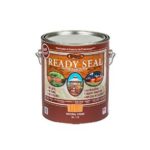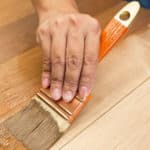Cedar is a popular wood for a lot of reasons. First, it is softwood, making it extremely easy to work with. However, even though it is softwood, it is relatively durable and mold and pest-resistant.
This makes it ideal for many different indoor and outdoor applications.
Although it is resistant to wear and tear, it will start to age rapidly if it is not properly treated. That means that any cedar wood should be stained. However, you want to ensure that you use the best stain for cedar.
Otherwise, you might be left with a previously beautiful wood project that is now unrecognizable.
We have put together a list of the 10 best stains for cedar, looking at exterior and interior options.
This article will also review what we found to be the top three choices for cedar wood projects.
Our Top Pick
In a hurry to apply a stain? Choose Ready Seal Stain and Sealer. It is easy to apply and dries quickly. It penetrates the wood to give it a natural appearance.
Top 10 Stains for Cedar Comparison Table
| Picture | Name | Interior or Exterior | Price | Rating (1-5) |
|---|---|---|---|---|
 | 1. Ready Seal 512 Natural Cedar Exterior Stain and Sealer | Exterior | $$$$ | 4.7 |
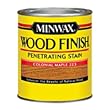
| 2. Minwax 222304444 Wood Finish Penetrating Interior Wood Stain, 1/2 pint, Colonial Maple | Interior | $ | 4.5 |
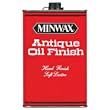
| 3. Minwax 67000000 Antique Oil Finish Natural, quart | Interior | $$ | 4.8 |
 | 4. Cabot Wood Toned Deck & Siding Low VOC Stain | Exterior | $$$ | 4.1 |
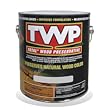 | 5. AMTECO DIVISION OF GEMINI INDUSTRIE TWP-1501-1 Gallon Cedartone VOC Stain | Exterior | $$$$ | 4.8 |
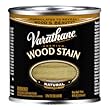
| 6. Rust-Oleum 211755 Varathane Oil Base Stain, Half Pint, Natural | Interior | $ | 4.5 |

| 7. OLD MASTERS 11916 Wip Stain, Cedar | Interior | $$ | 4.3 |
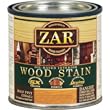
| 8. ZAR 12006 Wood Stain, Teak Natural | Interior | $ | 4.2 |
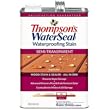
| 9. THOMPSONS WATERSEAL 042851-16 Semi Transparent Stain, Cedar | Exterior | $$$ | 4.5 |

| 10. THOMPSONS WATERSEAL 041851-16 Transparent Stain, Cedar | Exterior | $$ | 4.5 |
Tips That Will Help You Find a Quality Stain for Cedar
Whenever you are looking to stain a woodworking project, it is best to know what types of stains work best for your type of wood and what types of conditions your project will be subjected to; this is also true when you are looking for the best stain for cedar.
- Interior or Exterior. Depending on your project’s location, you want to ensure that you choose the proper type of stain. If your project is outside, you want to make sure you use an exterior stain. If you keep your project inside, you can use either stain.
Just be sure that if you select exterior for an interior project, you apply the stain in a well-ventilated area, as it usually has a sealant component. Once this is dried, it will be just fine indoors.
- Stain Color. All of the stains selected for our table are a natural color to allow the beauty of the wood to show through. However, you may select a different color stain for your project if you like.
Be sure to read the label on your stain container carefully and test it out on an inconspicuous spot before doing the whole project.
- Oil-Based. For cedar, a dense softwood, you want to make sure you use an oil-based stain designed to penetrate the wood fibers deeply.
Do not use a gel or water-based stain, as they will not penetrate the wood deeply enough and could result in rapid color fading and damage to the wood.
- Finish. There are several choices for the finish type for the exterior stains we highlighted. Each one is designed to give an extra layer of protection and to help waterproof the wood. Depending on the finish type, it may make the wood seem shiny. The different types of finish are:
- Clear. This will look the most natural.
- Transparent. It still will look relatively natural, with a bit of shine.
- Semi. It will start to darken the wood with moderate shine.
- Solid. It will darken the wood greatly and have the most shine.
If you use an interior stain, you will need a separate finish to help protect the wood. The glossier the finish, the more protected the wood. These can be purchased separately and come in the following:
- Clear. This will allow the stain to stay true to color with very little shine.
- Satin. This will make the stain somewhat darker and give a moderate shine.
- Semi-Gloss. The stain will appear darker and will have pretty much shine.
- Gloss. This will darken the stain the most and will have the most shine.
Top 3 Best Stain for Cedar Reviews
1. Ready Seal 512 Natural Cedar Exterior Stain and Sealer

Specifications:
- Size: 5 Gallon
- Color: Natural Cedar
- Material: Oil-based
- Pattern: Stain and Sealer
The Ready Seal 512 Natural Cedar Exterior Stain and Sealer was extremely effective at staining cedar.
It is a deep penetrating oil-based stain that went on smoothly. We put on two coats in our tests and let them sit for the recommended drying time.
Once it was dry, it did not have an odor or feel tacky to the touch. The natural cedar color we selected highlighted the grain in the wood well and brought out its natural beauty.
This is a semi-transparent stain and sealer. It comes in various colors such as Natural Cedar, Golden Pine, Mahogany, Redwood, Pecan, Burnt Hickory, Dark Walnut, and Light Oak.
When you first apply the stain, it may look darker than it should be, but that is fine. It takes 14 days to show the true color.
The only perceivable drawback to this product was that it does not come in an interior finish. However, as we laid out for you above, you can still use it for interior purposes.
It will require a bit more ventilation and drying time but would provide excellent durability to your interior cedar finishing project.
The stain went on easily and dried quickly. As an oil-based formula, it deeply penetrated the wood, giving it a beautiful, natural appearance.
While it is made for exterior projects, this is what we consider the best stain for cedar because it can be for exterior and interior applications.
2. Minwax Wood Finish Penetrating Interior Wood Stain

This is an interior stain that performed well in our tests. It is oil-based and deeply penetrates the wood fibers, giving them a beautiful natural look. It dried quickly and was easy to apply.
However, since it is made for interior applications, it does have some drawbacks that our number one choice did not have.
Since it is made for use on interior projects, we had to use polyurethane to finish sealing up our work. While this is also relatively easy to do, it takes double the time as the exterior product did.
It also means that, even after the poly had been applied, you would not be able to take your project outdoors; this makes it ineffective on something like siding or a deck.
While this went on quickly and easily and will give a beautiful look, there are some drawbacks. Since it is an interior stain, you will need to finish it with some sealant, which adds time. Even after has been sealed, it cannot be used outdoors.
3. Minwax 67000000 Antique Oil Finish Natural

Minwax Antique Oil Finish gives a beautiful finish to our wood project. Its oil-based formula penetrated the wood fibers deeply and quickly, allowing the natural wood grain to show through.
This stain is easy to apply. It goes on smoothly without being sticky. It is true to color, so it doesn’t change the color of your wood.
However, since it is made for interior projects, it has the same drawbacks as our number two selection.
You would need to use another finishing project to seal the wood completely, and even then, it would not be able to be used in an exterior application.
This product gives a beautiful look to your interior projects. However, you need to make sure that you seal them up with another product, and even then, they can’t be used outdoors.
4. Cabot Wood Toned Deck & Siding Stain

All-natural wood species, such as cedar, fir, pine, cypress, spruce, redwood, or composite materials that include wood granules can be stained with Cabot Wood Toned Deck & Siding Stain.
It penetrates deep into the wood fibers and seals them with a clear finish that protects all-natural wood species for years to come.
Cabot stain achieves an authentic wood tone and texture without changing the natural characteristics of the wood grain with its unique blend of polymers and pigments.
Select from ten unique tones, and combine them to create an unlimited number of beautiful effects. Cabot stain protects exterior wood for decks, siding, or outdoor surfaces.
Cabot stain brings out the natural beauty of your wood surface while protecting it from the damaging effects of sun, salt, and moisture.
5. AMTECO DIVISION OF GEMINI INDUSTRIE TWP-1501-1 Stain

The TWP-1501-1 is a 1-gallon container of TWP translucent waterproofing stain. With a single application, this stain protects your deck from sun, rain, and snow for years.
Built to last, the best part is the maintenance-free protection you’ll enjoy for the life of your project.
This oil-based, low VOC stain goes on smoothly and dries quickly with a beautiful finish. It produces a long-lasting waterproof surface as well as an improved appearance.
It is easy to apply and can be used on new and existing decks. Not only does the coat enable your deck to withstand different weather conditions, but it also greatly helps preserve the wood’s natural beauty.
Frequently Asked Questions
Do You Need to Treat Cedar For Outdoor Use?
Cedar is a popular choice for interior and exterior building projects due to its natural resistance to rot and decay. While a protective finish is not strictly necessary, it can help extend the wood’s life. For those who appreciate the aroma of cedar, however, it is best to leave the wood unsealed.
Western Red Cedar and incense cedar are two of the most popular varieties, and they are often used in saunas and closets because of their pleasant scent. In addition to its aesthetic and aromatic properties, cedar is also relatively easy to work with, making it a good choice for DIY projects.
Whether you seal it or not, cedar is an excellent option for various applications.
Can Cedar Wood be Stained?
Cedar is naturally resistant to rot and decay when used as a deck or a fence. Depending on the moisture and sun exposure, cedar can show deterioration from the weather and develop a gray appearance.
Cedar should be stained to maintain its natural appearance, especially if used as siding. By staining, you provide water and UV protection and prevent cracking.
How Do You Prepare Cedar for Staining?
Before staining the cedar, wash it with soap and water to remove accumulated dirt or dust. After you have washed it, wait for it to dry before you stain the cedar.
Remember to wash the cedar before you paint it, not after — because if you wash off your paint job before it’s dry, you may end up washing away all of your hard work!
How Often Should you Stain Cedar?
Staining your cedar fences, deck, and outdoor structures is recommended to protect them from the weather. A high-quality stain should last five to seven years.
The frequency at that you should stain your cedar depends on many factors, including the type of wood you have, your climate, and your usage of the decks.
Depending on the weather conditions, you may want to apply a clear coat every two years. Be sure to remove the loose or damaged wood before applying the stain.
What is the Best Primer For Cedar?
Use an oil-based exterior wood primer. If you use the Ready Seal 512 Natural Cedar Exterior Stain and Sealer, a primer is not needed, saving you a lot of time.
How Do You Stain Rough Cedar?
You can choose between a brush and a roller to treat rough-sawn wood. A brush is better for corners and for cutting along edges.
If you want to choose the rolling option, use a ¾” napped roller to push the stain deep into the grain. Don’t stain in direct sunlight because uneven absorption of the stain will cause blotching.
Should You Sand Cedar Before Staining?
If your cedar deck is new and you just finished it, you better sand it before staining. If your cedar deck is a few years old and in great shape, you could get away without sanding before staining.
If you live in a cold and snowy climate, you must sand your cedar deck before staining it. Cold weather can cause the wood to swell slightly, leaving gaps that a stain color can’t disguise.
On top of that, a new stain application will fill in voids and cracks for better wear resistance over time.
How Do You Keep Cedar From Turning Gray?
Staining a cedar fence can be challenging. You want the wood to look natural, but you also want the fence to last long. If you just allow the cedar to fade to a gray color as it ages, it will look very weathered and unappealing after several years.
The main reason cedar fences fade to gray is the ultraviolet light present in sunlight. This type of light causes the wood to turn gray as it ages.
Instead, you should choose a transparent or semi-transparent oil-based stain that protects the wood from ultraviolet rays and mildew without obscuring the natural coloring of the cedar.
Can Cedar be Stained Dark?
To get dark-stained cedar, use either polyurethane or lacquer. If you go with a longer-lasting exterior polyurethane coating, you can get a darker shade than if you choose lacquer. It will also take longer to penetrate the cedar pores with lacquer.
Therefore, if you put a darker stain on cedar decking, we recommend using clear-coat polyurethane and doing it in multiple coats instead of lumping it into one coat.
Remember that your deck is still cedar, and the results from a single-coat attempt are difficult to achieve.
How Long Does Cedar Wood Last?
If you are building a deck, a patio, or adding a pergola, you will want to choose cedar. This is because cedar is one of the most durable woods available and has the added benefit of resisting water.
And, as you probably know by now, staying dry is one of the best ways to increase the lifespan of any wood item.
Cedarwood lasts longer than most other woods because it’s naturally resistant to water, decay, and insect attacks. And its low water absorption rate keeps the wood from cracking or swelling when exposed to wet weather.
Cedar is a durable wood, which adds to its longevity. The combination of these factors makes for a deck that can last 15-20 years (or more) without needing much maintenance.
What Lasts Longer Cedar or Pressure Treated Wood?
A pressure-treated wood deck can last over 20 years when high-quality wood is used. But the fact remains that cedar decks generally last longer (15-20 years) than their pressure-treated counterparts.
Are Cedar Posts Rot Resistant?
Western Red Cedar is a slow-growing, long-durability wood naturally resistant to insects and rot. It may be subject to damage by decay fungi but is resistant to most insect attacks.
Western Red Cedar is the best choice over pressure-treated posts if you’re looking for rot-resistant fence posts. It provides beauty and value to your log cabin, garden fences, and more.
Is it Better to Stain or Paint Cedar?
You can help protect your cedar wood siding by either staining it or painting it. Painting is easier and less expensive, but sometimes not the best option.
The paint will eventually fade and crack if your home gets a lot of direct sunlight. Stains, however, are far more resistant to ultraviolet rays.
Ultraviolet rays will cause the paint to fade and deteriorate the cedar boards. Paint protects against UV rays, but stain protects against it even more.
Stain is more resistant to ultraviolet rays, ensuring that your siding looks great for a longer period.
Final Thoughts
Many like to work with cedar for decking, furniture, and siding. These uses make it popular, but the wood becomes stained once used.
Some stains work better than others. Some stains might just be expensive mistakes that you will be forced to replace at a certain point.
But if you want your cedar furniture to last sometime, you must understand how to take care of it properly. Stains are going to play an important role in its upkeep.

